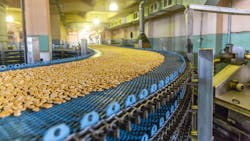Unlocking hidden value from production line data
End-of-line inspection is often seen as a binary decision — a product is either good or bad. However, most inspection systems generate a huge amount of additional data — and this often goes to waste. With the increased connectivity of devices and data analysis tools, it is now possible to unlock hidden value from this data through real-time insights into production that can be used to optimize processes.
Checkweighers, metal detectors, X-ray inspection systems and vision systems all monitor production to ensure quality and conformity of products. But, until now, the data used to decide whether any products need rejecting has been discarded immediately after the decision has been made. Any data shared has been limited to information such as whether the unit is running correctly or there are any signs of a fault.
That is now changing, thanks to a dramatic reduction in the costs associated with data collection, storage and analysis — along with new tools such as machine learning. For the first time, "fast-moving" data on the production line can be captured and analyzed to yield valuable benefits.
Measurements from a checkweigher, for example, can flag issues before they bring production to a halt. If four filling machines are involved in producing bags of cereal and one of them develops a fault that leads to overweight bags, high-level data might not suggest a problem if the batch averages across the four machines are within the accepted range. It is only when the individual weights are analyzed that a pattern emerges — allowing the issue to be identified and resolved.
Similarly, if the flow rate of a chocolate enrober coating multiple lanes of chocolate bars is uneven across the conveyor belt, data at a batch level will not flag the real problem. Without the insights from data on individual weights, the enrober will be adjusted to ensure all bars meet the required weight. But if the flow is uneven, this will mean some of the bars receive an extra-thick layer of chocolate — increasing costs compared with running the equipment at the optimal level.
Linking equipment data can also reveal useful information. If a weigh price labeler is linked to a vision system designed to ensure labels are properly applied, analysis of the contrast of the print on the label can provide an early warning that the print head is failing. This means preventative maintenance can be carried out to avoid an unplanned stoppage if the print quality falls below the required standard — something that is particularly crucial if the label includes key allergen information.
In a connected environment, the frequency of breakages in products such as boxes of cookies can also be monitored and flagged, with warning thresholds set lower than automatic reject thresholds. If a misaligned tool is causing a high proportion of cookies to be broken when placed into the packaging, data from X-ray inspection technology can highlight the issue before customer complaints start flooding in.
The latest X-ray inspection technology can also be used to check that the correct number of items are in a container. This, combined with a checkweigher, ensures the correct package weight is maintained, and the product is supplied as expected. The technology can also highlight the average size distribution of a product.
In a pack of four baking potatoes, for example, the total weight and the total number of potatoes is controlled, and any packs found to be non-conformant are rejected. But a pack containing three small and one large potato, while acceptable, is not as desirable as four similarly sized potatoes. With the size of each potato recorded by X-ray technology, this data can be made available for analysis — even if it is not used to make a rejection decision. And if, later, it is decided to change the rejection criteria, the historic data will be available to help with a data-driven decision regarding acceptable tolerances.
Traceability is another key issue where reliable data is vital. If, for example, there is an increase in the rate of bone contamination in packs of chicken breast fillets, it can be difficult to determine which supplier provided the non-conformant material — until now, this has been a largely manual, time-consuming process. If, however, the details of each unique inspection are automatically fed back to a central database which already has information on which starting batch was used and which intermediate equipment the product had passed through, it is much easier to determine how and why issues have arisen.
As we move towards a more connected factory, it becomes possible to label a product with details of not only where the raw materials came from, but which mixers, ovens and packaging machines were used. In the event of having to place a product on hold — or even recall it — this increasingly granular level of detail allows the scale of the disruption to be reduced.
As the quantity of data increases, so does the value of combining data from a variety of sources. Does the operation of one piece of equipment affect the behavior of a neighboring machine, for example, leading to a nonconformant product? By bringing a broad range of data into a single location, in real time, temporal and environmental factors can be more easily correlated with issues. And this interconnected data can be harnessed to reveal unprecedented hidden value in the production line.
Dr. David Bosworth is the head of product development at Sapphire Inspection Systems, a manufacturer of end-of-line X-ray inspection equipment. Along with a doctorate in material science, Bosworth has industry-leading knowledge of X-ray inspection at both a technical level and as it relates to solving customers’ problems.
